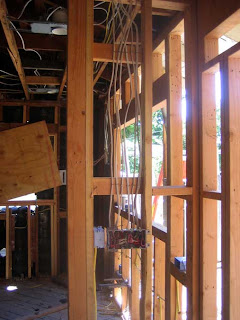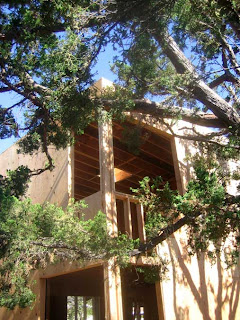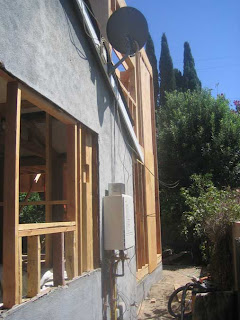
The main barrier to exploration and utilization of space is the cost of escaping the gravity well of the Earth. If it costs you $10,000 dollars per pound to put something into geosynchronous orbit then that is 1-2 million dollars for every person, and that doesn't include anything else that person might like to bring with him, like say air or some sort of barrier between them and the icy cold grip of space. When you total up all the stuff you are going to need, we are talking 20 million dollars a person minimum. Throw in the fact that every trip into space basically involves a controlled explosion and you can see why most of us remain fairly Earth-bound. One approach to this problem is to make rocketry more efficient. Many right-headed people think they may be able to get the costs down as low as $1000 per pound. At 2 million bucks a trip some sort of space tourism might occur, but it still seems likely that Space will be Terra Incognita for most of us.
Isn't there a better way?
In fact, there may be. If one were to suspend a cable from geosynchronous orbit to the ground, about 25,000 miles, you could run cargo up and down it for a fraction of the cost of rocketry. This concept is most often referred to as a Space Elevator, for which I have posted some futuristic concept art.
Why doesn't the cable fall? For the same reason that if you swing a yo-yo around your head the string stays taut, if you swing a space elevator cable around the Earth (and the Earth is doing the swinging just by turning around once every 24 hours) it will also remain taut. As you might guess there is a big problem with making a space elevator as none exist as of yet. As you swing your yo-yo around you have to keep tension on the string, i.e. you are pulling on it. Now imagine making the string longer and longer. You are going to have to swing the yo-yo faster, pulling on the string harder. At some point the yo-yo is going to be going so fast that the tension on it will be stronger than the string which will then break and you lose your yo-yo. The problem with the space elevator is finding a "string" strong enough to resist how fast we are going to have to swing it. And you can't just make a thicker cable. The thicker you make your cable, the heavier the cable will be, requiring even more tension to hold it in place. No presently available cable material (i.e. steel or nylon) has a high enough tensile strength compared to its weight to allow the production of a space elevator. They would all break.
That is, no material except for a substance called carbon nanotubes, which have the potential to put previous materials to shame, achieving factors of 100 times more strength for the same weight. Now all we need to do is manufacture it in quantities great enough to make a 50,000 km cable! Yeah, that is a small problem. Presently there is difficulty manufacturing enough of it to make a millimeter long cable. Still, from a theoretical standpoint there does not seem to be any reason this engineering problem can't be solved. Will it take 5 years or 25, I don't know. Such industrial quantities of nanotube material will have significant technological repercussions far beyond space travel, so believe me a lot of people are working on it.

In the meantime the Space Elevator fanatics are not sitting still. They have put together a yearly Space Elevator contest to help develop ideas and generate interest in the topic. A major secondary hurdle for the Space Elevator is powering the cargo up the 25,000 km to the top. No matter how you cut it, that is a long way to haul 20 tons of cargo. Traditional methods -- internal combustion engine, batteries, rockets -- all require bringing the fuel along for the ride, which is heavy, requiring more fuel, which makes it heavier... you get the idea. The simple solution is not to bring the energy producing stuff with you, but to beam it up to the elevator. No Scottie, not that kind of beam. A laser beam, which can hit a solar-type panel and power an electric motor. Build your giant lasers below your elevator and up it goes. It is true the laser will start to diverge/be absorbed as it goes upwards, but fortunately the higher you go on the cable, the lighter the elevator.

So every year there is a contest to build just such a ground powered space elevator. Well, since it only goes to the top of a 200-foot crane, maybe it should be called a crane elevator. Here are some examples of real life space elevator proto-types from the 2006 event. The first one is MClimber, the University of Michigan entry. You can see where light is being focused on the underside of the solar panels. This next one is the entry from the Kansas City Space Pirates -- surprise, surprise space elevator builders are geeky -- who use that snow shovel looking mirror to focus the light beamed from the ground onto a single solar bar. Finally we have the contest winner, from the University of Saskatchewon Space Design Team (USST) who climbed to the top of that 180 foot (55 m) cable in 57 seconds, just missing the cash prize for a 1 meter per second climber.

So, they have a ways to go. At 1 meter/sec it would take 289 days to reach geosynchronous orbit. The hope is something more like 200 miles/hour (90 m/s), which still takes over 3 days. Bring a book.
Speaking of books it feels like I just wrote one. These little intros are supposed to be teasers, not treatises. I blame slashdot for not having a quirky story this week for me to riff on, forcing me to pull out something requiring a lot of explanation. I promise next week to either have more healing plastic/rubber duck flotilla material or to abandon the "format" that I have presently slipped into altogether.

The house construction moves ever onwards and upwards. The past week has been all electrical all the time. Combined with the rough plumbing, my walls finally have the majority of their "guts". In this human body metaphor the framing is the bones, insulation is the fatty tissue, and the drywall the skin. And the HVAC would be the lungs and the flooring would be... the lymphatic system? Hrm. I really should think these metaphors all the way through before starting them.

Here are a series of photos showing exactly what all this electrical mumbo-jumbo involves. The first photo is a fairly typical example. The little blue boxes are the future homes of sockets connected by yellow wiring that has been strung inside the walls. The next photo shows a major switching station placed on the tiny piece of remaining wall between my den and kitchen. From there I will be able to control a ridiculous number of lights and possibly both the Hollywood sign and LAX airline traffic. You will notice white wiring coming up from the switches. You may also notice a couple of ceiling can lights up and behind.

This photo in the series shows more of these lights which will all be recessed into the future ceiling. This particular set of these lights is up in the loft, which just seems to get cooler as we proceed.

Here is our new electrical panel. I know I will miss the old one which required wedging the door against the water heater to access, but I suppose this one will be fine. Yes, it won't swing shut with a crash or contain an extended black widow spider family (who I think have all moved into my garage... but that is another story), but it will just have to do. No, I will not be able to enjoy running out to flip the breaker every time a vacuum cleaner is used for more than five minutes, but sacrifices will have to be made. Seriously, I will miss that old piece of crap electrical panel.
No, not seriously.
Now before I continue, I must know if you are prepared. Because below is awaiting the cutest damn thing ever.
I know, I know. I have put some fairly cute stuff on this blog before. The recent Potter stuff was nice. Babies at the beach is a classic. And then there was our valiant fight against Cranial Panis Mica (please give). And who could forget That's Show Biz..., a classic of its time.
But this is some grade A, uncut, pure and unadulterated cute.
Make sure you have fastened your seatbelts and put your trays in their full upright and locked positions.
'Cause it is go time.







































